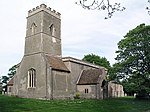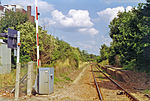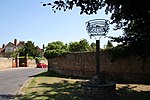Great Wilbraham (causewayed enclosure)
Great Wilbraham is a Neolithic causewayed enclosure, an archaeological site near the village of Great Wilbraham in Cambridgeshire, England. The enclosure is about 170 metres (560 ft) across, and covers about 2 hectares (4.9 acres). Causewayed enclosures were built in England from shortly before 3700 BC until at least 3500 BC; they are characterized by the full or partial enclosure of an area with ditches that are interrupted by gaps, or causeways. Their purpose is not known; they may have been settlements, meeting places, or ritual sites. The Great Wilbraham enclosure was first identified from aerial photographs in 1972. An excavation was begun in 1975 by David Clarke, with a planned five-year research programme, but Clarke died in 1976 and the results from the dig remained unpublished for years. The surviving part of the archive of finds and records from Clarke's dig was reanalysed in the 2000s, and published in 2006. The site was rich in finds, including Neolithic flint, pottery from periods stretching from the Neolithic to the present day, and animal bone—mostly cattle, but also some sheep and pig. Radiocarbon dating of two samples from the enclosure found dates inconsistent with their context, and were assumed to be the result of later material intruding into the Neolithic levels. The site has been protected as a scheduled monument since 1976.
Excerpt from the Wikipedia article Great Wilbraham (causewayed enclosure) (License: CC BY-SA 3.0, Authors).Great Wilbraham (causewayed enclosure)
Wilbraham Road, South Cambridgeshire
Geographical coordinates (GPS) Address Nearby Places Show on map
Geographical coordinates (GPS)
| Latitude | Longitude |
|---|---|
| N 52.197 ° | E 0.251 ° |
Address
Wilbraham Road
Wilbraham Road
CB21 5EU South Cambridgeshire
England, United Kingdom
Open on Google Maps










